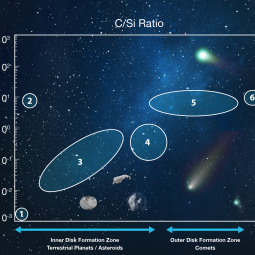By Charles “Chick” Woodward, Kassandra Bell, and Joan Schmelz
Paper:
The Coma Dust of Comet C/2013 US
10
(Catalina): A Window into Carbon in the Solar System
Woodward, Charles E., et al., 2021/02, PSJ, , 2.
SOFIA observations reveal that comets may be the source of carbon, an essential ingredient for life, for planets like Earth and Mars. Analysis shows that dynamically new comet, Comet C/2013 US 10 (Catalina), is carbon-rich, suggesting that it formed in the outer regions of the primordial solar system before delivering carbon to the terrestrial planets. These results reveal cometary dust carbon-to-silicon (C/Si) atomic ratios much higher than those of carbonaceous-chondrite meteorites, suggesting the outer protoplanetary disk, the realm where comets first formed, was richer in carbon than the inner disk. This finding contributes to newly proposed interpretations of disk processing in the primitive solar system.
Comets are remnants of solar system formation. They have remained cryogenically “preserved” in the Oort Cloud for the last 4.5 billion years, minimally processed and retaining a record of the volatile and refractory material incorporated into their nuclei from the protoplanetary disk. Remote sensing of their comae probes the chemistry present in the natal solar system. Comet nuclei likely incorporated both processed nebular matter as well as material from the interstellar medium (ISM). Deciphering how terrestrial planets might form in habitable zones with stable biospheres requires understanding the pathways of biogenic elements abundant in the ISM gas phase as materials are processed and redistributed within the disk. These materials were aggregated into rocks and ices, eventually accreted by terrestrial bodies. In particular, the disposition of carbon, the keystone in the chemistry of life, is of keen interest.
The inner regions of the solar nebula, closest to the primordial Sun, were so hot that only rocky material could survive. The terrestrial planets formed in this environment where elements like carbon were destroyed or removed via disk winds. SOFIA observations can address this so-called “carbon deficit,” where rocky bodies in the inner solar system including the Earth are generally depleted in carbon compared to outer regions of the solar nebula where it was cool enough for carbon to survive.
SOFIA observations show comets have C/Si atomic ratios similar to the ISM and the Sun. These results indicate the solid state materials present in the outer disk that were incorporated into comets efficiently sequestered carbon from the abundant carbon reservoir inherited from the ISM. The FORCAST instrument on SOFIA with its suite of grisms can spectroscopically observe the emission emitted from the coma of comets at mid-infrared wavelengths (from 6 to 40 micron) that host a variety of solid-state spectral features arising from dust compositions including amorphous and crystalline silicates.
Thermal model analysis of the SOFIA-observed infrared spectral energy distribution revealed that Comet Catalina is an example of a subset of comets with weak silicate features and high C/Si ratios. The thermal emission from their coma is dominated by warmer particles that are significantly more absorbing at UV-near-IR wavelengths than silicates. The FORCAST spectral band provided a constraint that required the presence of amorphous carbon as a dominate constituent of the coma particle population. This analysis suggests that a carbon-rich reservoir existed in the regimes of comet formation.
Jupiter, with its enormous size and gravitational forces, created a diving line between the carbon-poor inner regions and carbon-rich outer regions of the solar nebula, preventing mixing between them. Researchers think that a slight change in Jupiter’s orbit allowed small, early precursors to comets to deliver carbon from the outer to inner regions, where it was incorporated into the formation processes of the rocky planets. This delivery possibly occurred during the early pebble accretion phase of primordial disk evolution when the motions of aggregating materials, including comet dust grains, are dominated by inward pebble drift contemporaneous with initial coalescence of comet nuclei.
As we observe more comets with SOFIA, including dynamically new comets, will a significant population of carbon-rich comets arise? If so, the challenge will be to fold these discoveries into protoplanetary disk mid-plane models of processing of primitive materials, migration of refractory dust, volatiles, and organic species as planets grow, and accretion seeding of evolving rocky worlds in the habitable zones. Confirmation of how comets and asteroids delivered these materials and pre-biotic precursors to the terrestrial planet zone, potentially catalyzing life, may soon be within reach.
